Class Mammalia
Order Carnivora
Family Canidae
Urocyon cinereoargenteus—Gray Fox // Urocyon littoralis—Island Fox // Urocyon/Vulpes—Gray or Red Fox
Likely all of the mainland Rancholabrean fossils from our region referred to Urocyon are of the common mainland modern species (U. cinereoargenteus). Size is close to that for Vulpes macrotis and V. velox, but the "step" in the dentary (Fig. 1) is diagnostic as is the configuration of the temporal ridge on the frontals and parietals. The islands off the coast of California host a different species, U. littoralis, characterized primarily by small size.

Fig. 1. Right dentary of Urocyon cinereoargenteus from U-Bar Cave. Note the "step" on the ventral border near the posterior portion of the dentary (this is not the angular process, which is missing at the far end).
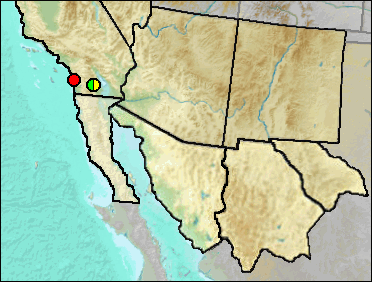
Sites.
Late Blancan/Irvingtonian: Anza-Borrego (Murray 2008).
Late Pleistocene: Wanis View (Jefferson 2014: Cf.).
Literature. Jefferson 2014; Murray 2008.
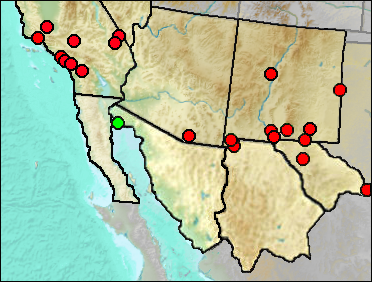
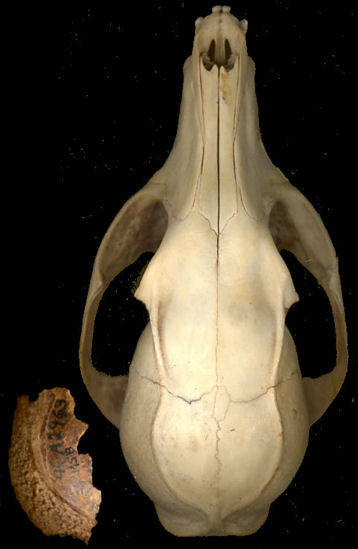 Gray Foxes are
common throughout our region in rough terrain, from low desert into coniferous forest.
They seldom are found far from mountainous country. They are at home in wooded areas
and are known as good climbers.
Gray Foxes are
common throughout our region in rough terrain, from low desert into coniferous forest.
They seldom are found far from mountainous country. They are at home in wooded areas
and are known as good climbers.
Several occurrences were listed in Harris (1993c) or Jefferson (1991b) as Urocyon sp., but are included here as U. cinereoargenteus, as is the El Golfo record.
Fig. 1. Modern Urocyon cinereoargenteus skull and a fossil fragmentary left parietal from Isleta Cave No. 2. The surface below the temporal line in Urocyon is notably roughened. Because of the lighting and preservation, the roughness of the portion below the temporal line in the fossil is exaggerated, whereas the lighting and angle on the equivalent area of the modern specimen de-emphasizes the roughness.
Sites.
Irvingtonian: El Golfo (Croxen et al. 2007: gen. cf.).
?Late Irvingtonian/Rancholabrean: Emery Borrow Pit (Jefferson 1991b: cf. gen.).
Rancholabrean: Papago Springs Cave (Skinner 1942).
Rancholabrean/?Early Holocene: Mitchell Caverns (Jefferson 1991b: cf. gen.).
Wisconsin: Carpinteria (Wilson 1933: cf.).
Early/Early-Mid Wisconsin: Balcony on Lost Valley (Harris 1993c: cf.); Lost Valley (Harris 1993c); Rm Vanishing Floor (Harris 1993c); Sabertooth Camel Maze (Harris 1993c).
Mid Wisconsin: Papago Springs Cave (Czaplewski and Mead et al. 1999); Pendejo Cave (Harris 2003); U-Bar Cave (Harris 1987).
Mid/Late Wisconsin: Diamond Valley (Springer et al. 2009).
Mid/Late Wisconsin/Holocene: Anthony Gap Cave (UTEP); Rancho La Brea (Stock and Harris 1992); Sierra Diablo Cave (UTEP).
Late Wisconsin: Blackwater Loc. No. 1 (Morgan and Lucas 2005); Camel Room (Harris 1993c); Cueva Quebrada (Lundelius 1984); La Mirada (Jefferson 1991b: cf.); Maricopa (Jefferson 1991b); Park Place, Irvine (Jefferson 2014); U-Bar Cave 15-18 ka (Harris 1989); U-Bar Cave 18-20 ka (Harris 1989: cf.).
Late Wisconsin/Holocene: Conkling Cavern (Harris 1993c); Howell's Ridge Cave (Harris 1993c); Isleta Cave No. 2 (UTEP); Kokoweef Cave (Reynolds, Reynolds, et al. 1991); Newberry Cave (1991b); Pendejo Cave (Harris 2003); Schuiling Cave (Jefferson 1991b); Williams Cave (Ayer 1936).
Literature.
Ayer 1936; Croxen et al. 2007; Czaplewski and Mead 1999; Harris 1987, 1989, 1993c, 2003; Jefferson 1991b, 2014; Lundelius 1984; Morgan and Lucas 2005; Reynolds, Reynolds, et al. 1991; Skinner 1942; Springer et al. 2009); Stock and Harris 1992); Wilson 1933).
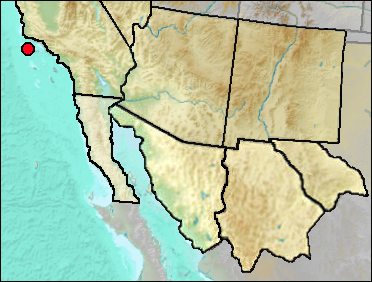
Sites.
Mid/Late Wisconsin: San Miguel Island (Guthrie 1998).
Literature.
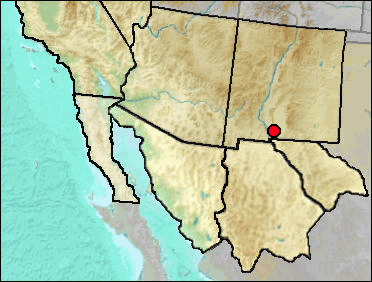
Similarity in size makes it difficult to separate post-cranial elements of Urocyon and Vulpes.
Sites. Mid Wisconsin-Holocene: Shelter Cave (Harris 1993c).
Literature.
Last Update: 29 May 2015